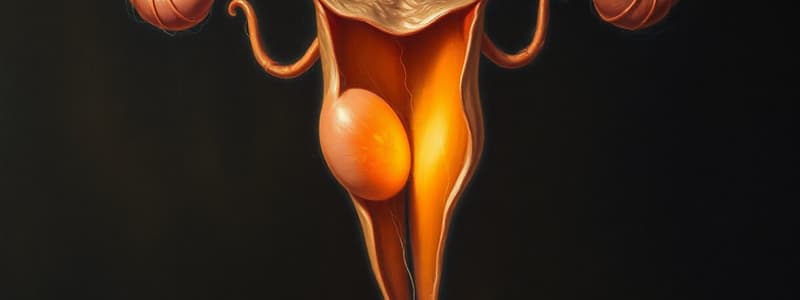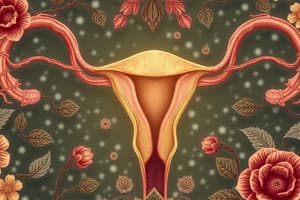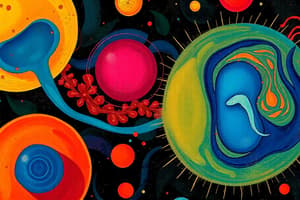Podcast
Questions and Answers
The human reproductive system produces, stores, nourishes, and transports functional male and female reproductive cells called:
The human reproductive system produces, stores, nourishes, and transports functional male and female reproductive cells called:
- ovaries
- testes
- gametes (correct)
- gonads
Fertilization, also known as conception, is where a male gamete and a female gamete:
Fertilization, also known as conception, is where a male gamete and a female gamete:
- mitose
- unite (correct)
- splice
- divide
A ______ is the term used for the single cell created by the fusion of a male gamete (from the father) with a female gamete (from the mother).
A ______ is the term used for the single cell created by the fusion of a male gamete (from the father) with a female gamete (from the mother).
zygote
The gradual transformation of a single cell into a functional adult, over 15 to 20 years, is the process of _______, which is directed by hormones of the reproductive system.
The gradual transformation of a single cell into a functional adult, over 15 to 20 years, is the process of _______, which is directed by hormones of the reproductive system.
The reproductive system includes each of the following components EXCEPT:
The reproductive system includes each of the following components EXCEPT:
In both males and females, the reproductive system ducts are connected to chambers and passageways, constituting the ______ that open to the exterior of the body.
In both males and females, the reproductive system ducts are connected to chambers and passageways, constituting the ______ that open to the exterior of the body.
In adult males, the testes secrete sex hormones called:
In adult males, the testes secrete sex hormones called:
During emission, mature spermatozoa travel along a lengthy duct system where they are mixed with secretions of accessory glands forming:
During emission, mature spermatozoa travel along a lengthy duct system where they are mixed with secretions of accessory glands forming:
In adult human females, the ovaries (female gonads) typically release only one immature gamete, called an oocyte, per:
In adult human females, the ovaries (female gonads) typically release only one immature gamete, called an oocyte, per:
The immature oocyte travels along short uterine tubes, ending in a muscular organ called the uterus, and a short passageway called the ______ connects the uterus with the exterior.
The immature oocyte travels along short uterine tubes, ending in a muscular organ called the uterus, and a short passageway called the ______ connects the uterus with the exterior.
During sexual intercourse, ejaculation of the male introduces semen into the vagina and the ______ ascend the female reproductive tract and if a sperm reaches the oocyte in the uterus the process of fertilization is initiated.
During sexual intercourse, ejaculation of the male introduces semen into the vagina and the ______ ascend the female reproductive tract and if a sperm reaches the oocyte in the uterus the process of fertilization is initiated.
After initialization of fertilization, the oocyte matures into an ovum, and the uterus is enclosed to support the next step of development into a:
After initialization of fertilization, the oocyte matures into an ovum, and the uterus is enclosed to support the next step of development into a:
Proceeding from a male testis, spermatozoa travel within each of the following except:
Proceeding from a male testis, spermatozoa travel within each of the following except:
Accessory organs of the male reproductive system, which secrete various fluids into the ejaculatory ducts and urethra, include each of the following except:
Accessory organs of the male reproductive system, which secrete various fluids into the ejaculatory ducts and urethra, include each of the following except:
The male external genitalia consists of the:
The male external genitalia consists of the:
In the testes, ______ are responsible for the production of androgens, the dominant sex hormones in males.
In the testes, ______ are responsible for the production of androgens, the dominant sex hormones in males.
Spermatozoa are generated by the process of spermatogenesis, which involves three integrated processes in the following order:
Spermatozoa are generated by the process of spermatogenesis, which involves three integrated processes in the following order:
Spermatogonia (stem cells) divide by ______ to produce daughter cells, some of which differentiate into primary spermatocytes.
Spermatogonia (stem cells) divide by ______ to produce daughter cells, some of which differentiate into primary spermatocytes.
Meiosis is a special form of cell division involved in gamete production, where gametes contain:
Meiosis is a special form of cell division involved in gamete production, where gametes contain:
In the seminiferous tubules, meiotic divisions that begin with primary spermatocytes produce:
In the seminiferous tubules, meiotic divisions that begin with primary spermatocytes produce:
Spermatozoa are:
Spermatozoa are:
The principal organs of the female reproductive system include each of the following EXCEPT the:
The principal organs of the female reproductive system include each of the following EXCEPT the:
Which of the following functions do the ovaries not perform:
Which of the following functions do the ovaries not perform:
The interior tissues, or ______ of the ovary can be divided into: (a) superficial cortex (where gametes are produced); and (b) deeper medulla.
The interior tissues, or ______ of the ovary can be divided into: (a) superficial cortex (where gametes are produced); and (b) deeper medulla.
Oogenesis (or ovum production), begins before a woman's birth, accelerates at puberty, and ends at menopause, and between puberty and menopause, oogenesis occurs monthly as part of the:
Oogenesis (or ovum production), begins before a woman's birth, accelerates at puberty, and ends at menopause, and between puberty and menopause, oogenesis occurs monthly as part of the:
The female stem cells, oogonia (unlike spermatogonia) complete their ______ divisions before birth.
The female stem cells, oogonia (unlike spermatogonia) complete their ______ divisions before birth.
Between the ______ of female fetal development, the daughter cells (primary oocytes), prepare to undergo meiosis.
Between the ______ of female fetal development, the daughter cells (primary oocytes), prepare to undergo meiosis.
After undergoing the first steps of meiosis the process comes to a halt and the primary oocytes remain in a state of suspended development until the individual reaches puberty when rising levels of ______ trigger the start of ovulation.
After undergoing the first steps of meiosis the process comes to a halt and the primary oocytes remain in a state of suspended development until the individual reaches puberty when rising levels of ______ trigger the start of ovulation.
Not all primary oocytes produced during development will survive until puberty and while the ovaries have around 2 million primordial follicles at birth (each containing a primary oocyte), degeneration by a process called ______ results in a drop in this number to around 400,000 by puberty.
Not all primary oocytes produced during development will survive until puberty and while the ovaries have around 2 million primordial follicles at birth (each containing a primary oocyte), degeneration by a process called ______ results in a drop in this number to around 400,000 by puberty.
The follicular phase is also known as the:
The follicular phase is also known as the:
Which step occurs AFTER ovulation?
Which step occurs AFTER ovulation?
The menstrual (uterine) cycle averages 28 days in length in humans and can be divided into three stages in which order
The menstrual (uterine) cycle averages 28 days in length in humans and can be divided into three stages in which order
During menses there is a degeneration (and progressive loss) of the functional zone of the endometrium, which is sloughed by a process called:
During menses there is a degeneration (and progressive loss) of the functional zone of the endometrium, which is sloughed by a process called:
In the days after menses, there is a functional reorganization for restoration of the functional zone of the endometrium, stimulated and sustained by:
In the days after menses, there is a functional reorganization for restoration of the functional zone of the endometrium, stimulated and sustained by:
The secretory phase of the uterine cycle lasts around:
The secretory phase of the uterine cycle lasts around:
The activity of the female reproductive tract is under hormonal control, involving an inter-play between secretions of both the ______ and the gonads to co-ordinate the ovarian and uterine cycles.
The activity of the female reproductive tract is under hormonal control, involving an inter-play between secretions of both the ______ and the gonads to co-ordinate the ovarian and uterine cycles.
Which of the following is NOT an estrogen circulating in the bloodstream:
Which of the following is NOT an estrogen circulating in the bloodstream:
Each of the estrogens have similar effects on target tissues and these include each of the following EXCEPT:
Each of the estrogens have similar effects on target tissues and these include each of the following EXCEPT:
Mammary glands are specialized organs of the female integumentary system that are controlled mainly by hormones of the reproductive system and by the ______, a temporary structure that provides the embryo or fetus with nutrients.
Mammary glands are specialized organs of the female integumentary system that are controlled mainly by hormones of the reproductive system and by the ______, a temporary structure that provides the embryo or fetus with nutrients.
______ usually defined as the time that ovulation and menstruation cease, is accompanied by a decline in circulating concentrations of estrogen and progesterone and a sharp sustained rise in the production of gonadotropin-releasing hormone (GnRH), follicle-stimulating hormone (FSH), and luteinizing hormone (LH).
______ usually defined as the time that ovulation and menstruation cease, is accompanied by a decline in circulating concentrations of estrogen and progesterone and a sharp sustained rise in the production of gonadotropin-releasing hormone (GnRH), follicle-stimulating hormone (FSH), and luteinizing hormone (LH).
Flashcards
What are gametes?
What are gametes?
Male and female reproductive cells, responsible for sexual reproduction.
What is fertilization?
What is fertilization?
The union of a male gamete (sperm) and a female gamete (egg), marking the beginning of a new organism.
What is a zygote?
What is a zygote?
The single cell formed after fertilization, containing genetic material from both parents.
What is development?
What is development?
Signup and view all the flashcards
What are gonads?
What are gonads?
Signup and view all the flashcards
What is the reproductive tract?
What is the reproductive tract?
Signup and view all the flashcards
What are androgens?
What are androgens?
Signup and view all the flashcards
What is semen?
What is semen?
Signup and view all the flashcards
What is ovulation?
What is ovulation?
Signup and view all the flashcards
What is the uterus?
What is the uterus?
Signup and view all the flashcards
What is the vagina?
What is the vagina?
Signup and view all the flashcards
What is the journey of sperm?
What is the journey of sperm?
Signup and view all the flashcards
What is an embryo?
What is an embryo?
Signup and view all the flashcards
What is the epididymis?
What is the epididymis?
Signup and view all the flashcards
What is the prostate gland?
What is the prostate gland?
Signup and view all the flashcards
What are the male external genitalia?
What are the male external genitalia?
Signup and view all the flashcards
What are interstitial (Leydig) cells?
What are interstitial (Leydig) cells?
Signup and view all the flashcards
What is spermatogenesis?
What is spermatogenesis?
Signup and view all the flashcards
What is mitosis?
What is mitosis?
Signup and view all the flashcards
What is meiosis?
What is meiosis?
Signup and view all the flashcards
What is spermiogenesis?
What is spermiogenesis?
Signup and view all the flashcards
What is oogenesis?
What is oogenesis?
Signup and view all the flashcards
What is the ovarian cortex?
What is the ovarian cortex?
Signup and view all the flashcards
What is the ovarian medulla?
What is the ovarian medulla?
Signup and view all the flashcards
What is the ovarian cycle?
What is the ovarian cycle?
Signup and view all the flashcards
What is atresia?
What is atresia?
Signup and view all the flashcards
What is the follicular phase?
What is the follicular phase?
Signup and view all the flashcards
What is the corpus luteum?
What is the corpus luteum?
Signup and view all the flashcards
What is the menstrual (uterine) cycle?
What is the menstrual (uterine) cycle?
Signup and view all the flashcards
What is menses?
What is menses?
Signup and view all the flashcards
What is the proliferative phase?
What is the proliferative phase?
Signup and view all the flashcards
What is the secretory phase?
What is the secretory phase?
Signup and view all the flashcards
What is the pituitary gland?
What is the pituitary gland?
Signup and view all the flashcards
What is estradiol?
What is estradiol?
Signup and view all the flashcards
What is menopause?
What is menopause?
Signup and view all the flashcards
Study Notes
Reproductive System - Self Assessment
- Reproductive cells: The human reproductive system produces, stores, nourishes, and transports functional male and female reproductive cells called gametes.
- Fertilization (Conception): Fertilization, also known as conception, is the union of a male gamete and a female gamete. This results in a single cell.
- Zygote: The single cell created by the fusion of a male and female gamete is called a zygote.
- Development: The gradual transformation of a single cell into a functional adult takes approximately 15-20 years and is controlled by hormones of the reproductive system. This process is called development.
- Reproductive System Components (EXCEPT): The reproductive system includes gonads, ducts, accessory glands and organs, but not pineal structures.
- Reproductive System Ducts: Reproductive system ducts are connected to chambers and passages. These open to the exterior of the body.
- Male Sex Hormones: In adult males, the testes secrete sex hormones called androgens.
- Emission and Semen: During emission, mature spermatozoa are mixed with secretions from accessory glands to form semen.
- Female Gametes: In adult human females, ovaries typically release only one immature gamete (oocyte) per day/month/week/year.
- Uterus and Uterine Tubes: The immature oocyte travels through short uterine tubes to the uterus. A short passageway, called the vagina, connects the uterus to the exterior.
- Fertilization Process: During sexual intercourse, male semen enters the vagina, enabling spermatozoa to travel up and potentially fertilize an oocyte in the female reproductive tract leading to fertilization.
- Development After Fertilization: After fertilization, the oocyte matures into an ovum, and the uterus supports the developing embryo and fetus.
- Spermatogenesis: Spermatozoa are produced via spermatogenesis, a process involving mitosis, meiosis, and spermiogenesis.
- Spermatozoa Location: Spermatozoa are highly specialized cells in the body.
- Male Reproductive Organs: Accessory organs of the male reproductive system include seminal vesicles, prostate gland, and bulbourethral glands. These secrete fluids into the ejaculatory ducts and urethra.
- Male External Genitalia: The male external genitalia are the scrotum and penis.
- Male Sex Hormone Production: In the testes, interstitial (Leydig) cells produce androgens, the dominant sex hormones in males.
- Female Reproductive Organs: The principal organs of the female reproductive system include the uterus, uterine tubes, and vagina.
- Ovarian Functions: The ovaries produce immature female gametes and secrete female sex hormones. They do not secrete follicle-stimulating hormone (FSH).
- Ovarian Cycle: The female reproductive system has an ovarian cycle involving phases, including proliferative, menses, and secretory phases.
- **Menstrual Cycle (Oogenesis):**The menstrual cycle (ovarian cycle) is about 28 days long and involves oogenesis beginning before birth, accelerating at puberty, and ending at menopause.
- Ovarian Divisions: The interior tissues (stroma) of the ovary can be divided into a superficial cortex (where gametes are produced) and a deeper medulla.
- Ovulation Related Processes: Following ovulation, there are processes that occur to prepare for potential fertilization, such as the formation of the corpus luteum.
- Menstruation: Menstruation is the sloughing of the functional zone of the endometrium via a process called menstruation.
- Uterine Cycle Phases: The secretory phase of the uterine cycle lasts about 14 to 28 days.
- Hormonal Regulation: The activity of the female reproductive system is controlled by the interaction of hormones from the pituitary gland and the gonads.
- Ovarian Hormones: Estrogens are important circulating ovarian hormones.
- Effects of Estrogens: Estrogens have several effects on target tissues, including stimulating bone and muscle growth, maintaining female secondary sex characteristics, affecting central nervous system activity, and initiating shedding of the endometrium.
Studying That Suits You
Use AI to generate personalized quizzes and flashcards to suit your learning preferences.




